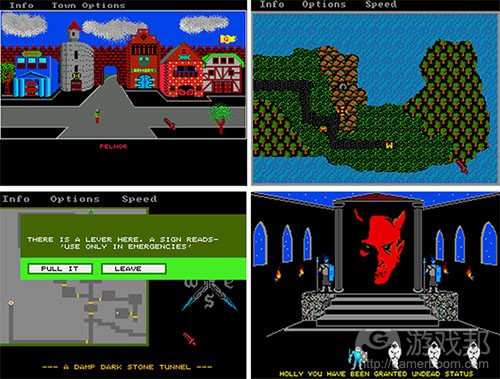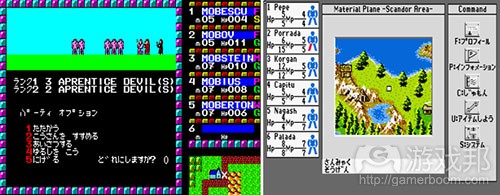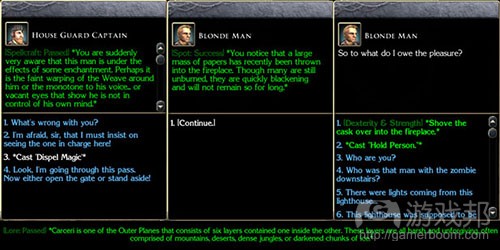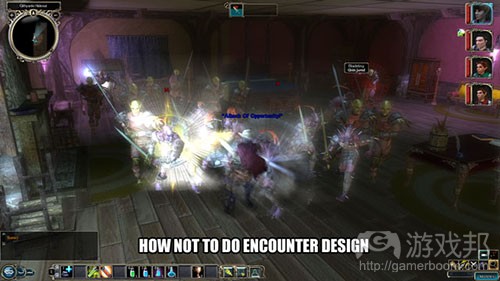越来越多RPG向我们呈现出一些全新的内容
作者:Felipe Pepe
上个月我暂时转向了本土文化对于游戏的影响的讨论,而今天我将在此重新讨论模糊的电脑角色扮演游戏(CRPG)!
《Phantasie》系列
从70年代到80年代,关于RPG我最喜欢的一件事便是其“前沿”感,没有人拥有关于事情发展的计划,人们只是在此不断尝试不同的事物。
Douglas Wood的《Phantasie》便是其中的一款“前沿”游戏,并采取了非常独特的方法。与《假面骑士》的第一人称图像或像《创世纪》的自上而下机制不同的是,它使用了各种不同的视图。城镇动画的侧视图,世界地图与《创世纪》类似,而地牢则拥有迷你地图般的视图。你并不需要坐标纸或基本的方向感—-游戏为你准备了这一切,并伴随着各种陷阱,遭遇和基于文本的互动。这是一种简单但却优雅的体验。
除了独特的地图系统外,死亡也同样让人印象深刻。一旦失败,你的那一方将接受Hades的审判,他能够复活一些人,永久杀死一些人,也能够将某些人变成不死人!
战斗也拥有独特的视图,角色将并行排列于底部,而敌人将出现在上方的不同行列中。但同时玩家还可以选择各种不同的种族,包括传统的地精,矮人,精灵,牛头人,食人妖,豺狼人,蜥蜴人以及上述提到的不死人!
发行于1987年的《Phantasie III: The Wrath of Nikademus》升级了视图并添加了一个新功能:区域破坏。现在你可以伤害,打破或移动战斗中对象的特定身体部分,包括能够利用运气吹击而砍下敌人的头部。
让人遗憾的是《Phantasie》系列却不像《创世纪》系列那般持久。它对于日本拥有更大的影响,在这里最初的游戏得到了StarCraft Inc的改造,即拥有了侧视图的战斗:
整个游戏系列在日本取得了巨大的成功,1991年Douglas Wood和StarCraft开发了《Phantasie IV:Birth of Heroes》,而到现在它也仍然是只针对于日本市场的游戏。
几年前Douglas Wood曾在RPG Codex的访谈上提到他正致力于《Phantasie V》,但很遗憾在那之后该项目便被取消了。
《Hillsfar》(1989年)
回到80年代末,SSI是当时主导着策略和RPG游戏市场的发行巨头。游戏中的母鸡不会下金蛋,但这却是一款虚构的Gold Box AD&D RPG游戏。从1988年到1992年,SSI发行了超过11款这样的游戏,还包括一些衍生游戏。
然而还是有人认为这还不够,所以SSI决定与Westwood Studios合作并创造了《Hillsfar》,并且这款游戏被描述为独立包装的支线任务。
从根本上看这款游戏是从《光芒之池》或《Curse of the Azure Bonds》等游戏输入角色并将他带到了《Hillsfar》中的城市,在这里他能够参与一系列小游戏,如在竞技场中战斗,掠夺房子,比赛箭术,骑马,浏览永久编程的幻想酒馆的描述。
当你在城镇上完成一个公会的简短任务后(游戏邦注:取决于你的角色类别),你便可以将角色重新输出到主要的Gold Box游戏中,并且这时候他将带有额外的生命值。
其实这款游戏本身是一个糟糕的理念,尽管一开始迷你游戏很有趣,但是它们也非常局限且很容易变得无聊。唯一的例外便是具有开锁技能的迷你游戏。
而发行于26年前的《Hillsfar》仍然是我迄今为止看过的最优秀的开锁技能迷你游戏。从根本上看你将拥有一系列选择,并且你必须在有限时间内做出正确的选择去开启每一把锁。这是非常让人紧张的情况,需要极快的速度以及敏锐的眼睛,快准狠是绝对的优势。
我必须说说GOG.com中的一些无名英雄所做出的贡献,它们一直在努力保护Gold Box游戏并重新发行它们,《Hillsfar》便是其中的一员。
《Snatcher SD》(1990年)
因为本周的讨论是《合金装备V》,所以让我们也来谈谈小岛秀夫的游戏《Snatcher》。这款游戏发行于1988年,是一款奇异的冒险游戏/视觉小说的结合体,在这里机器人将想办法得到人们的身体,而只有Junker代理Gillian Seed能够阻止他们!
《Snatcher》是一款优秀的游戏,这里充满了许多小岛的理念,并且也被用于之后的《合金装备》中,但这也是一款冒险游戏,所以我不想在此进行过多描述。
真正让我感兴趣的是在《Snatcher》发行两年后,小岛决定重新启动这款游戏。即添加了一些可爱且超级畸形的图像以及第一人称回合RPG战斗。
是的,你没看错,战斗既是第一人称也是回合制。
在每个回合中你将选择一把枪并使用标线去瞄准屏幕上的点,你可以击中机器人的身体而对他造成伤害,或者在特定情况中这可以降低对方的生命值或者能够将其彻底消灭。举个例子来说吧,攻击对方的眼睛/传感器能够降低他的精确度,如果你拥有极大的威力,那么击中对方的眼睛有可能导致他将不能再攻击你。
这是一种非常原始的系统,并且也非常适合这款游戏。它甚至会扔出一些特别的设定,如敌人将使用人质之类。不幸的是这款游戏也非常磨人,有些战斗需要玩家花费许多时间,并要求你先削弱敌人再慢慢将其消灭。
但不管怎样我还是很高兴能够看到一些现代游戏中再次出现这样的游戏概念。
《影子大地》(1992年)
我将从二手信息的危害性这样的警世故事开始这款游戏的分析。我所浏览过的一些网站和帖子提过,游戏拥有区域伤害,就像《Phantasie III》那样:
然而这却是未经核实的误报。左图的那些身体实际上是游戏奇异的控制方案!
点击右腿能够移动一个角色,而点击左腿则能够移动整个群组。同时,右手能够使用道具或发动攻击,而左腿则能够选择道具或进行互动。头部是用于阅读或吃东西。这种设定很奇怪,但在几分钟后你却能够熟悉这一切。
你可以看到《Shadowlands》是第一款突出了一群能够独立移动的角色的实时RPG游戏,因此在面对这一具有实验性的控制系统时,没人知道该怎么做!在玩游戏的时候你会发现它非常新颖,当你在面对需要你分解群组并让成员执行各种不同的手段的谜题时,你会觉得开发者的脑洞也太大了。
另一个具有创造性的功能便是名为Photoscope的照明系统。整个游戏环境拥有实时模拟的灯光,而这便需要每一个单一的灯光资源,包括电筒,魔咒和阴影等。游戏本身便是根据这一独特的功能所命名,设计师同样也将其应用于谜题上要求玩家使用特定的光度去解决谜题。
在《Shadowlands》之后又出现了《Shadoworlds》,从根本上来看它们是相同的,但后者的大背景则是在太空上。
我还很喜欢的一个细节便是你能够选择各种角色的背景故事。虽然这是一些外观上的变化,但却非常吸引人。
《Maimed God’s Saga》(2010年)
作为《无冬之夜2》的模组,这款游戏待在这里可能会委屈了点,因为在执行计算机游戏中的角色扮演以及在如何超越陈规的意象与陈腔滥调方面它算得上是大师级的角色。
该模组的创造者Russ Davis(游戏邦注:他也同样致力于《无冬之夜2:西门之谜》中)选择了一个非常大胆的方向:尽管《无冬之夜2》是以其执行了大量的《龙与地下城》规则集,并伴随着各种类别而出名,但是该模组却只是致力于Tyr的牧师。
你的任务很简单,因为一个女性写信给Tyr教堂寻求帮助,告诉对方自己的家庭受到了诅咒。随后你将被调往这个女性所居住的遥远城镇并去调查这一诅咒。
游戏的进行是不同的,它不像地下城潜行或呈现出科幻般的神奇力量那样,从根本上看来这就是一款冒险游戏,并且是由你的属性和选择所控制着。
它从各种方面上利用了牧师。例如,与其它《龙与地下城》般的CRPG游戏不同的是,当你在睡觉的时候你的法术不会自己回来。你需要找到一个祭坛并向Tyr祈祷。有时候Tyr会给予回应,提供给你一些看法或警告。然而当你第一次到达村庄时,你会自然地找到一个祭坛并祈祷,而如果发现祭坛已经被摧毁时,你则会想办法去重建它。
同样的,你每日的魔法选择不只是会影响战斗。例如祝福咒语能够带给你攻击检定中+1的勇气和决心奖励值并且能够抵挡恐惧。这是我们在RPG中能够看到的内容,但这一模组却提醒着我们这是来自以上帝之名的牧师的祝福—-它能够赋予Tyr力量,并用于净化一切。
整个模组都充斥着这些互动,就像向着迷的警卫投掷驱逐魔法,或向一个想要烧毁证据的人投掷Hold Person咒语:
同样的情况也会发生在技能检定上,即用于解决问题并帮助玩家沉浸于游戏世界中以及主角的情感上。
举个例子来说吧,Lore技能意味着你的角色清楚自己周围的世界。当有人谈论一些不常见的学科时,成功的Lore检定将呈现给玩家关于他们所谈论的内容的简要描述。而失败则意味着玩家将不清楚他们在谈论什么内容。
在最初的《无冬之夜2》中,战斗总是拥有可怕的遭遇设计和节奏。通常情况下你的冒险群组将进入一间小房子,然后将继续前进并杀死房间中的敌人,而这就像一个小丑车笑话一样无聊:
《Maimed God’s Saga》选择的是完全相反的方向,即创造有意义且简短的遭遇。在你穿越树林的时候,你不会无端消灭了5讴个半兽人—-你会先遇到一群半兽人与你交谈,并且它们试图攻击你。同样地,山上的小城堡只有4个守卫以及少量的房间,并且只会出现少量的土匪,而不是一个有着5层楼的巨大城堡以及200个暴徒这样的设定。
这样的设定也让所有的事物都变得更有分量了。
《Maimed God Saga》向我们展示了一款RPG可以多复杂且多有魅力,并且问题永远都不是关于“《被遗忘的过度》/《龙与地下城》很无聊很过时”,而是因为这些机制经常被用于一些无聊且过时的方法中。
(本文为游戏邦/gamerboom.com编译,拒绝任何不保留版权的转发,如需转载请联系:游戏邦)
CRPG History Abridged III – The revenge of more RPGs that brought something new to the table
by Felipe Pepe
Last month I made a brief pause to talk about the impact of local cultures in games, but today I’m back to rant about obscure CRPGs! Check part I and part II here if you missed, and let’s dive into it.
The Phantasie series (1985-1991)
One of the things I most enjoy about RPGs from the 70′s and 80′s is that “frontier” feeling, as no one had a blueprint on how to things, people just kept trying different things.
Douglas Wood’s Phantasie, is one of those frontier series, with a very unique approach. Instead of first-person graphics like Wizardy or top-down like Ultima, it used various distinct views. Towns were animated side-view screens, the world map was Ultima-like and dungeons had a fascinating mini-map-like view. You didn’t need graph paper or even a basic sense of direction – it was all there, filled with various traps, encounters and text-based interactions. Simple, yet elegant.
Besides the unique map system, death was also memorable. Upon defeat, your party was judged by Hades, who would resurrect some, kill others permanently and bring a few back as undead!
Combat had a unique look, with character laid side-by-side in the bottom and enemies displayed in various rows on top. But also because of the multitude of races players could play, from traditional elves and dwarves to fairies, minotaurs, trolls, gnolls, lizardmen and the aforementioned undead.
Phantasie III: The Wrath of Nikademus, released in 1987, upgraded the visuals and added a new feature: locational damage. Now you could injure, break or remove specific body parts in battle, including the chance to decapitate an enemy with a luck blow.
Sadly, the Phantasie series failed to endure as much as the Ultima games. It did have more of an impact in Japan, where the first game received an remake by StarCraft Inc, with side-view battles:
The whole series made so much success in Japan that in 1991 Douglas Wood and StarCraft developed Phantasie IV: Birth of Heroes, which remains to this day a Japan-exclusive.
A few years ago Douglas Wood also mentioned in a RPG Codex interview that he was working on Phantasie V, but sadly the project was canceled since.
Hillsfar (1989)
Back in the late 80′s, SSI was a giant publisher that dominated the Strategy and RPG markets. Its hen layed not golden eggs, but the fabled Gold Box AD&D RPGs. Like, a lot. From 1988 to 1992, SSI released no less than ELEVEN of those, plus some spin-offs. Suck on that, Assassin’s Creed.
Somehow, someone thought that wasn’t enough and so SSI reached to Westwood Studios to produce Hillsfar, a game best described as a stand-alone pack of side-quests.
Basically, you import a character from the Pool of Radiance or Curse of the Azure Bonds Gold Box games and take him to the city of Hillsfar, where he can engage in a series of mini-games, like fighting in an arena, robbing houses, competing in an archery contest, riding a horse and visiting the most amusing depiction of a fantasy tavern to ever be programmed.
After finishing a brief quest for one of the guilds in town (which depends on yout character class), you can then export your hero back to the main Gold Box games, along with some bonus XP and hit points. (I wonder how many power gamers played this just to buff their characters).
By itself the game isn’t a bad idea, but while the mini games are interesting for the first time, they are extremely limited and get boring fast. The sole exception is the lock picking mini game.
Released 26 years ago, Hillsfar still has the best lock picking mini game I’ve seen. Basically you have a set of picks and must use the correct one to open each of the lock’s tumblers, under a harsh time limit. It’s tense, requires speed & good eyes, scales very well and even – shock – makes sense!
BTW, a big shout out to the unsung heroes at GOG.com, who managed to scavenge the Gold Box games from legal hell and just re-released them, Hillsfar included.
Snatcher SD (1990)
Since the talk of the week (and likely month) is Metal Gear Solid V, let’s talk about a Hideo Kojima game, Snatcher. Released in 1988, it’s a bizarre adventure game/visual novel hybrid where robots are taking the bodies of people and only JUNKER agent Gillian Seed can stop them!
Snatcher is a great game, full of ideas Kojima would later use in MGS, but it’s an adventure game, so I have little to say about it here. If you’re curious, try this extensive Hardcore Gaming 101 article.
What interests me is that two years after releasing Snatcher, Kojima decided to make a reboot of it. With cute super-deformed graphics and first-person turn-based RPG combat.
Yes, you read that right, combat is first-person AND turn-based.
Each turn you pick a gun and use the reticule to aim at a point on the screen – you can fire at the robot’s body to deal damage, or at specific points to decrease its stats & eventually cripple it. For example, attacking its eyes/sensors will reduce its accuracy, and if you deal enough damage the eyes will be destroyed and he won’t be able to hit you anymore (and will likely self-destruct).
The twist is that before you fire the enemy will likely move, meaning aiming for small areas is tricky – you’ll have to anticipate his move or stop him from moving by destroying its legs. Different guns also have different speeds and damage area, so choosing your equipment is important.
It’s an extremely original system, that suits the game perfectly. It even throws some curveballs, like enemies using hostages. Unfortunately, the game is very grindy and some battles take a long time to beat, requiring you to first weaken the enemy and then slowly damage it…
Still, I would love to see some modern iteration of this concept.
Shadowlands (1992)
I’ll open this one with a cautionary tale on the dangers of second-hand information. Some websites & posts I read mentions the game has a locational damage, similar to Phantasie III, as seen here:
That’s misinformation being repeated without any fact checking (I found quite a few while researching for the book). Those bodies on the left picture are actually the game’s bizarre control scheme!
Click on the right leg to move a single character, click on the left leg to move the whole party. Meanwhile, the right hand uses items or attacks, while the left one picks up items or interacts. The head is used to read or eat held items. It’s weird, but you get the hang of it after a few minutes.
You see, Shadowlands is the first real-time RPG to feature a party of characters that can be moved individually – thus this primitive, experimental control system – no one knew how to do this! You can tell how novel this was just by playing the game, you can feel how excited the developers where to feature puzzles that required you to split your party and make them operate various levers.
Another innovative feature was the lighting system, called Photoscope. The whole environment had real-time simulated lighting, that would acknowledge every single light source, from torches to magic spells and cast shadows accordingly. The game itself is named after this unique feature, and the designers also employed it on puzzles that required a certain level of light or darkness to solve.
Shadowlands was followed by Shadoworlds, which is basically the same game, but IN SPACE!
A nice detail I enjoy is the back story of the various characters you can pick. It’s entirely cosmetic, but still fascinating. I would definitely play a game based on these guys.
The Maimed God’s Saga (2010)
This brilliant Neverwinter Nights 2 mod more than deserve its place here, for it’s a master class on how to do role-playing in a computer game and how to go beyond the usual tropes and cliches.
The module’s creator, Russ Davis (who also worked on NWN2′s Mysteries of Westgate), went in a bold direction: while NWN 2 is know for its extensive implementation of the D&D ruleset, with dozens of classes and prestige classes, the module is solely devoted to Clerics of Tyr.
Your quest begins simple, as a woman writes to the church of Tyr begging for help, saying her family is cursed. You are then dispatched to the remote town where she lives to investigate the curse.
The twist is in how the game plays, not as a dungeon crawl or a epic power fantasy, but almost as a adventure game, controlled by your stats and choices.
It makes full use of the Cleric, in various was. For example, unlike other D&D CRPGs, your spells won’t return when you sleep. You are required to find an altar and pray to Tyr. And sometimes Tyr will reply, showing you visions or warnings. However, when you first arrive at the village, you will naturally go after an altar to pray, and finding it in ruins you’ll seek the means to rebuild it & purify it.
Similarly, your daily choice of spells will affect more than just combat. For example, the Bless spells give a +1 morale bonus on attack rolls and on saving throws against fear effects. That’s all we see in RPGs, but this module reminds us that it’s a blessing from a cleric in name of a God – it carries Tyr’s power, it can be used to purify, to cleanse.
The whole module is full of these interactions, like casting Dispel Magic on a charmed guard, or Hold Person on a man trying to burn evidences:
The same thing happens with skill checks, that are used to solve issues and to help immerse players into the game’s world and the sensibilities of the main character.
For example, the Lore skill means your character knows about the world around him. When someone talks about uncommon subjects, a successfully Lore check will present the player with a brief description of what they are talking about. Failing it means be left in the dark about what they said.
Even in combat the game shines. The original NWN2 campaign had horrible encounter design and pacing. Often your party of adventurers would enter a small house and then proceed to murder hordes of copypaste enemies inside massive rooms, in what felt like a clown car joke:
Maimed God’s Saga expertly goes in the opposite direction, making encounters meaningful and short. You won’t casually cut 50 mindless orcs during your stroll trough the wood – you’ll encounter a small group of orcs that will talk to you, but also might attack and likely kick your ass. Similarly, the small keep in the mountains has only 4 guards and a handful of rooms, and the leader of a small pack of bandits is right next to the bandits, not at the end of a giant castle with 5 floors and 200 thugs.
These things matter. They make things have weight, purpose.
The Maimed God Saga is a reminder of how complex and enticing RPGs can be, of how the problem was never “Forgotten Realms / D&D is boring and cliche”, but how it’s often used in boring and cliche ways, as nothing more than a bunch of numbers to kill goblins and battle dragons.
Finally, I mentioned this before, but just so we keep this in mind: this mod and thousand others were originally hosted at IGN’s NWN Vault, which was pulled down without any warning. We only have access to gems like these thanks to devoted fans that fought to backup everything.(source:Gamasutra)













































 闽公网安备35020302001549号
闽公网安备35020302001549号